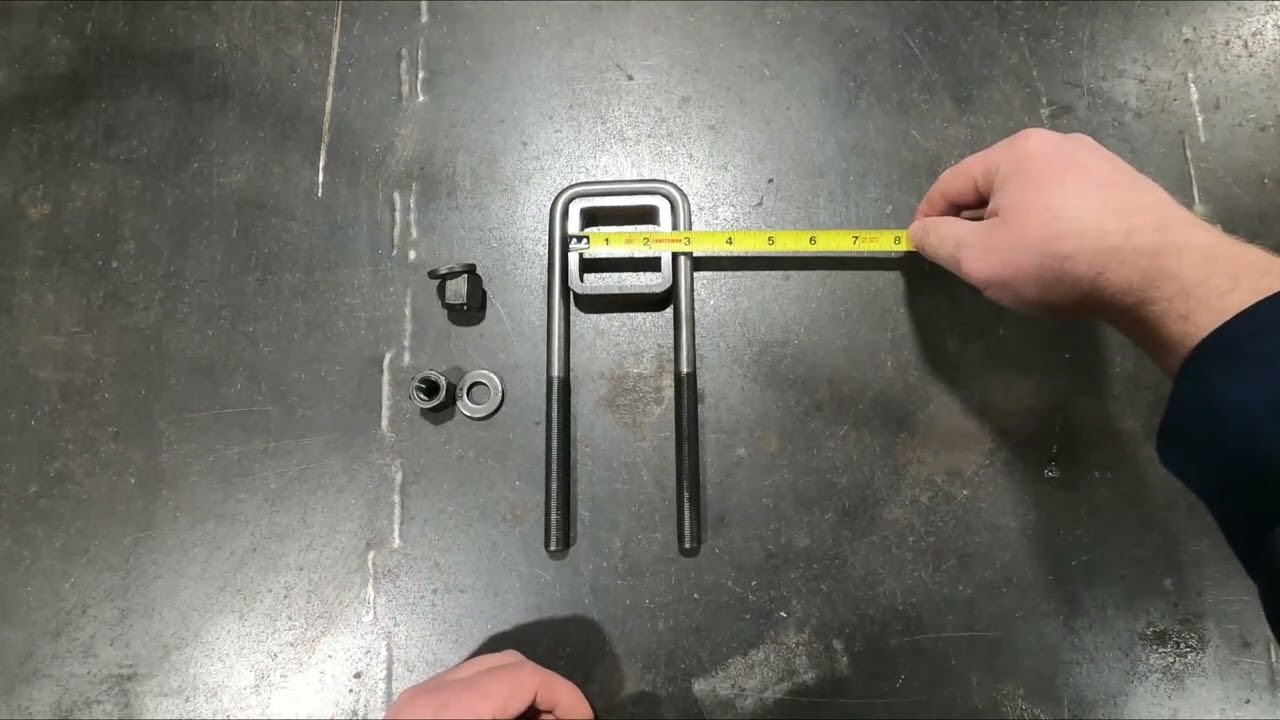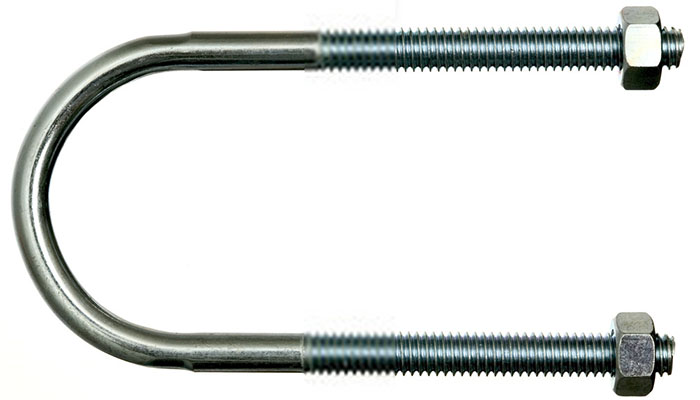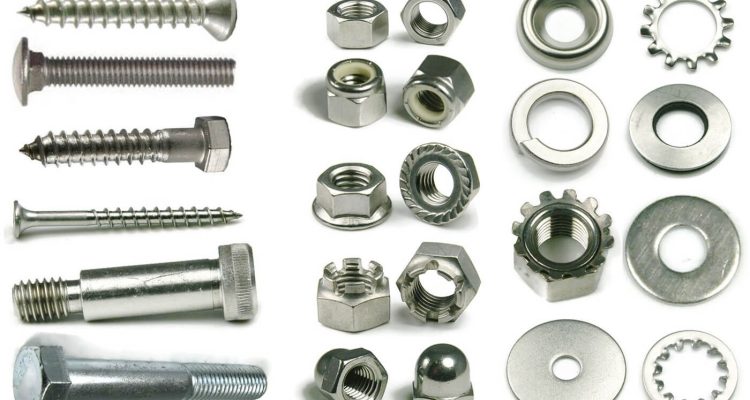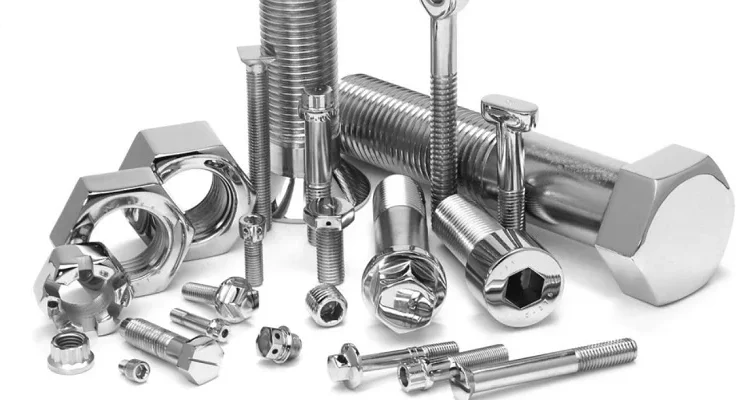
5 Tips For Properly Measuring U-Bolts
To accurately measure U-bolts, identify the type, use a caliper for diameter, measure full length, check thread size with a gauge, and verify the material and coating
Identify U-Bolt Type
It all begins with identifying the type of U-bolts in question as this remains the single most important step in measuring U-bolts. The most common shapes of U-Bolts are round, square and semi-round. Understanding the differences between these types is paramount not just for accurate measurement, but to understanding when and for what type of application each is suited.
ROUND U-BOLTS
The primary use of round U-bolts is in plumbing and electrical installations where circular objects like pipes or conduits need to be held in place. Their design should fit over round surfaces with a good grip, so there is no moving or sliding to avoid disturbing the system. For round U-bolts, it is very important to get your inner diameter correct so the U-bolt fits snugly around your pipe, without a large flat spot.
Square bend U-Bolts
You see them in countless construction and infrastructure jobs, square U-bolts. Great for linking square or rectangular goods to a surface. These U-bolts have to sit primarily on flat surfaces and should properly align in a way that will allow for the best strength, support and meeting the need to keep everything just that much straight. Square U-bolts should be measured based on the angles and flat sides be parallel to avoid torque stresses when completed.
Semi-Round U-Bolts
Image Credit: QuoraSemi-round U-bolts are a bit less usual as well as are most frequently utilized where neither rounded neither square U-bolts are absolutely appropriate. They are commonly used in automotive suspensions where they need to go around a partially rounded object. For semi-arc U-bolts, it is necessary to measure both the round and the plane, because they are needed to ensure the strength of the two between the rounded and flat connection.
Insights from the Real World
For example, in automotive repair, accurately selecting and measuring the right U-bolt size for a suspension system on a vehicle is very important. A semi-round U-bolt that adepts to the partial curvature of the chassis would distribute the clamp pressure more evenly and low-profile, alleviating wear in service. The same goes for use under the sea, such as round U-bolts made out of stainless steel that are used to secure equipment on boats, where need for accurate diameters comes into play in order to withstand impacting forces due to the corrosive environment of salty waters.

Accurately Measure Diameter
Accuracy is absolutely important when it comes to measuring the diameter of a U-bolt and that starts from choosing the correct tools. The measurements are usually done by using a digital caliper, which can achieve a high level of accuracy, usually within ±0.02 mm. In many cases, this very precise measurement is truly make it or break it when the joint or assembly depends on the exact diameter of the U-bolt.
Measuring the Inner Diameter
Measure accurately the distance between the inside spaces of the two legs of a U-bolt at its widest width. In this way, your U-bolt is guaranteed to snugly wrap around the item you want to fasten. In the industrial workplace, not providing the exact diameter may cause a loose grip resulting in the pipe moving or under pressure leaking.
Taking U-Bolt Tolerance into Account
Manufacturing tolerances must be considered while taking measurements of U-bolts. Most industry standards will allow for a diameter tolerance band. In other words, a U-bolt meant for a heavy-duty application will have tighter tolerances than one used for a less critical application. Being aware of the tolerance that is allowed can help you to discern whether a U-bolt lies within the acceptable range necessary for your individual needs.
Automotive Use
In automotive application, it is essential to have the right diameter size of U-bolts for the fastening of vehicle axles. If a U-bolt is too small, it can cause your axle to slip positioning and impact your vehicle’s handling as well as safety. The U-bolt diameter must be measured against the specifications for the axle so that the bolt fits tightly and securely.
Consistency in Measurement
Always measure the U-bolt in the same way to reliably measure it. For larger projects with various U-bolts of similar size, this consistency is paramount. Variable measurements can result in irregular force application and weak joints in the building or assembly.
Determine Length and Thread Length
The correct U-bolt total length needs to be correctly measured to ensure the U-bolt is able to hold the components securely together. To measure the overall length, place tape measure or ruler at the bottom of the U-bolt’s curve and extend to the end of threads. Remember to take the measurement from the inside of the curve, as this theoretically represents the length of the U-bolt that will be in direct contact with the materials you intend to secure.
Checking the Right Length for Applications
For example, in construction, knowing the proper length of a U-bolt ensures that it can span the materials being connected while providing adequate amount of thread engagement for securing a junction. A more specialized version of this separate but related concept is the French estrope which, when used to secure two items, is an S-shaped hook secured by an eyelet; both items were used as a conjoiner with a rope, cable or other tethers; though such applications are more commonly found in sailing due to the lack of cranes or lifts, this has been adapted for use in industrial construction where cranes are available, as for example in assembling the steelwork of large building structures to further secure U-bolted pipe tethers along the length of the bridge. If the U-bolt is too short, the engagement will not be enough and the U-bolt will be a safety hazard.
Measuring Thread Length
The length of the thread is just as important as it dictates to what extent the U-bolt can be used to create a secure fastening. When measuring the thread length, you start at the tip to the beginning of the thread which is the end of the U-bolt. This measurement helps to determine if there is enough space to accommodate nuts and washers that are important when tightening the U-bolt properly.
Industry Standards and Thread Length Specifications
In a number of industries (automobile, marine etc) thread length is defined and specified to ensure that all fastenings are structurally able to cope with the additional environmental stresses. For instance, in case of marine applications with boating industry which uses thicker material to construct a boat for withstanding the pressures of the water, longer threads may be required for U-bolts.
Uniform Standards of Measurement
A common effort of measuring U-bolts assure that the process will be reliable. For example, a machine assembly used in an industrial application may be subject to mechanical stress due to its weight; in such an application, U-bolts are used to secure the machine components together because of their ability to distribute an even stress load among the bolts, thus extending the functional life of the machine.
Select Proper Thread Size
Choosing the right thread size for U-bolts is essential for a tight fit and safe load-bearing! Thread size will normally include (diameter) x (pitch). Diameter = Width of the threadPitch = Distance between two threads Common measurement for U-bolts might be ranging from 1/4 inch in diameter on the lower side for light applications up to 1 inch or even more depending on the purpose of the U-bolt.
Thread size measuring tools
Thread gaugeThread gauges are the most precise way to measure the size of U-bolt threads. This tool will help you to fine tune the threads of the U-bolt with an actual gauge showing you the exact measurements. Its use is crucial in applications requiring exactitude, such as in mechanical systems development, where any lack of conformance to design specifications may lead to poor performance, failure of the mechanism or even catastrophic consequences.
Thread size varies by industry standard
Thread Size are Standardized—7/8-20, 16 TPI ensures used end parts of various manufacturers are compatible. In the United States, for example, Unified Thread Standard (UTS) is common, used for Americans, under UNC (coarse), UNF (fine), UNEF (extra fine) as designations for thread size. These dimensions also help ensure the size of the U-bolts is a close fit to holes in the custom brackets, and are directly related to matching the proper nut and washers to be used at assembly.
Infrastructure Project
U-bolts are necessary to secure safety barriers to infrastructure development projects, as in the case of building a highway overpass. In such applications, opting for a U-bolt having a coarse thread (Ex: UNC) can be advantageous as coarse threaded U-Bolts are less susceptible to come loose in vibration under heavy traffic.
Compatible with Nuts and Washers
Thread Size of the Nuts and Washers:It is essential to verify that the thread size of the U bolt is compatible with the nuts and washers used with it. If a mismatch occurs a poor fit is the end result, and the integrity of the connection will suffer. This is especially critical for applications like automotive, where a robust connection is required to prevent the car from falling to pieces when under stress.

Verify Material and Coating Durability
For U-Bolts, it is important to check that the material will be suitable for the requirement of the application in its use. U-blots are made of carbon steel,stainless steel and alloy steel etc. There are many qualities and flaws that each material has value wise; for example, carbon steel is tempered and allows for many uses, but can be prone to rusting if it is not very well preserved.
The Role of Material Selection in Various Environments
Stainless steel U-bolts are preferred when the use of the U-bolts are in environments where they will be exposed to corrosive elements – specifically in the marine or chemical processing industries. Actual experience shows that, in the right environment, stainless steels are also resistant to rust far in excess of the four weeks suggested, making them clean and safe for long-term use.
Admitted Strengths of Coating Types
U-bolts with a coating, suchjson gloss-zinc or hot-dip galvanizing, also help increase the service life and combat environmental factors. For example, or an exterior construction and automobile, a galvanized coating technology can be applied to prevent rust. The performance is determined by the thickness and the adhesion of these coatings, as measured by traditional assessments per ASTM B117 (ROHS salt spray).
Evaluating Coating Quality
Type of coat: A poor coat quality can reduce the life of U-bolts and the safety of the application. Indeed, the thickness of the coating can be easily controlled and without bubbles or gaps. Engineers test coating samples for adherence and thickness in compliance with industrial safety and longevity standards as part of bridge foundations, highways and other industrial settings.
Car Suspension Systems
U-bolt materials and coatings are important component of automotive suspension systems. The high stress and exposure to road salts and moisture make this a very high-end material and coating. Testing has demonstrated that a U-bolt that is properly coated with D-Flange epoxy and cured will allow the U-bolt to remain embedded to the configuration and maintain its elastic abilities under harsh conditions which is particularly important to ensuring vehicle safety and performance.



